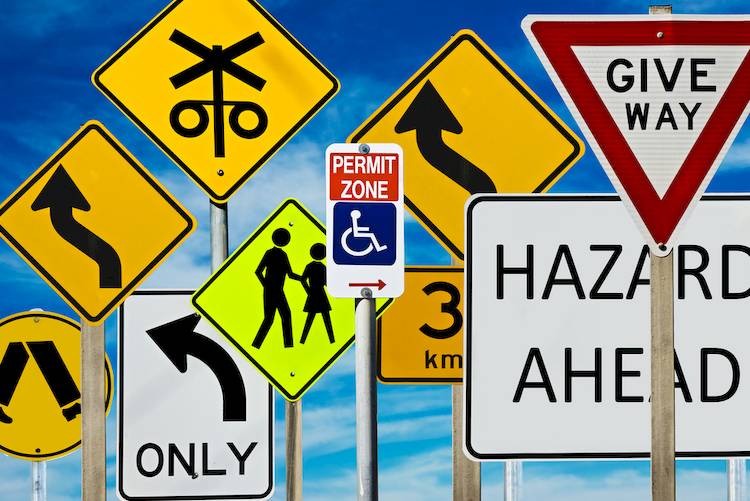

Do you know the rules of the road in Oklahoma? While a lot of traffic laws are consistent from state to state, there are some important differences. If you live in Oklahoma or you’re planning a trip there soon, you should be aware of the state’s laws and how they could pertain to you.
General safety regulations
Motorcyclists - Motorcyclists and motorcycle passengers who are 17 years of age and younger must wear helmets when riding. In order to operate a motorcycle, you must have an Oklahoma state driver’s license, and if the motorcycle has a piston displacement of over 250cc, then you must also have an Oklahoma motorcycle license permit.
Seat belts - Seat belts must be worn and properly fastened at all times by drivers and front seat passengers. Seat belts must be factory installed, and they must meet federal safety standards.
Children requirements - Children under the age of six years old must ride in a baby seat or other child passenger restraint system appropriate to the child’s size and weight. All children under the age of 13 must ride in a child passenger restraint system or wear a seat belt, whether or not they are in the front seat of the vehicle.
Right on red - When approaching a red light in Oklahoma, it is legal to make a right on red after you have come to a complete stop, and checked if the intersection is clear.
Emergency vehicles - Drivers must always yield to any emergency vehicles entering the roadway, making turns, or overtaking. These include police cars, ambulances, and any other emergency vehicles.
U-turns - Oklahoma state law permits u-turns except where there is a sign prohibiting them at a particular intersections.
Best practices for drivers
Passing - Making a pass on the left is permitted in Oklahoma when there is a dashed yellow or white line marking the boundary between lanes. Do not pass if you see a solid yellow or white line, or if you see two solid yellow lines on either side of a dashed yellow line. Passing on the right is prohibited.
Four-way stops - The first driver to arrive at the intersection and comes to a complete stop has the right of way. If two or more drivers arrive at the same time, the driver on the right will have the right of way, followed by the vehicle to the left of them, and so on.
School buses - Drivers must stop for and yield to school buses on either side of the road whenever the bus driver has activated the red flashing lights and “STOP” sign. Failing to stop for a school bus can result in doubled fines.
Flashing traffic lights - A flashing yellow light means you should slow down and make sure the intersection is clear before you proceed. Treat a flashing red light as you would a stop sign. If a traffic light is out and there is no flashing light at all, treat it as a four-way stop.
Blocking intersections - Blocking an intersection is illegal in Oklahoma. If traffic ahead of you won’t allow you to clear the intersection, stop before entering the intersection and wait until the way is clear.
Pedestrians - Whether you are turning or entering an intersection, you must yield to pedestrians who have already entered a crosswalk. The “Walk” and “Don’t Walk” signals at some crossings are there for the protection of pedestrians and should be obeyed.
Metering lights - Some states have to aid drivers merging in high-traffic times, but Oklahoma does not. When entering a freeway, drivers must enter in the accelerating lane, stay to the right, and yield to vehicles already on the freeway, and adjust their speed to merge into the flow of traffic.
Bicycle lanes - In the state of Oklahoma, bicyclists have the same rights and must follow the same rules as motor vehicles, whether or not a bicycle lane is present. Drivers overtaking bicyclists must pass with at least three feet of clearance.
Accidents - In the case of an accident that does not involve injuries or fatalities, drivers involved in the accident should make all possible efforts to clear the roadway of their vehicles and any other obstructions. Call the police and wait for law enforcement to arrive to determine fault and issue a citation to the at-fault party.
Driving Under the Influence (DUI) - Driving under the influence of alcohol can and will result in a DUI. Anyone over the age of 21 who is caught with a blood alcohol content (BAC) of 0.08 or higher will have their license revoked for a given period of time even if they are not subsequently convicted of a DUI. Drivers under the age of 21 who are found with any alcohol in their system will face the same penalties.
Oklahoma state license plate - A valid Oklahoma state license plate must be displayed on the back of the vehicle at all times. Failure to do so could result in fines and/or impounding of the vehicle.
Radar detectors - Oklahoma does not have a specific state law concerning radar detectors for private vehicles. However, use of these detectors is already prohibited by federal law for commercial vehicles.
If you want more information to the rules of the road in Oklahoma, visit Oklahoma Driver’s Handbook.



